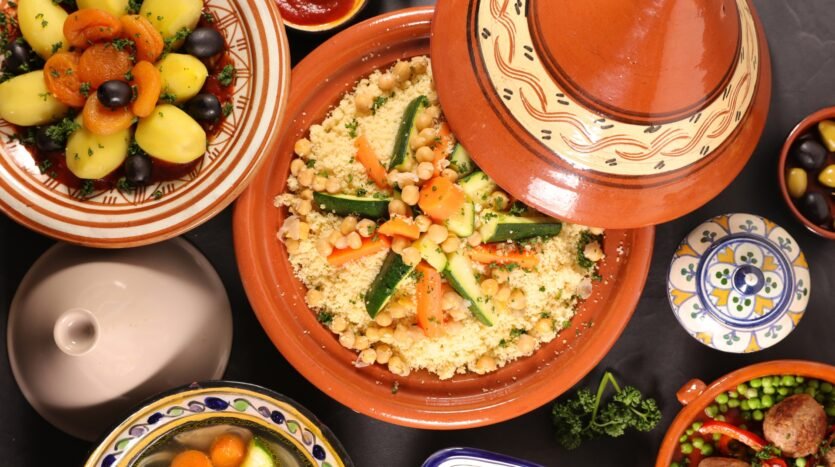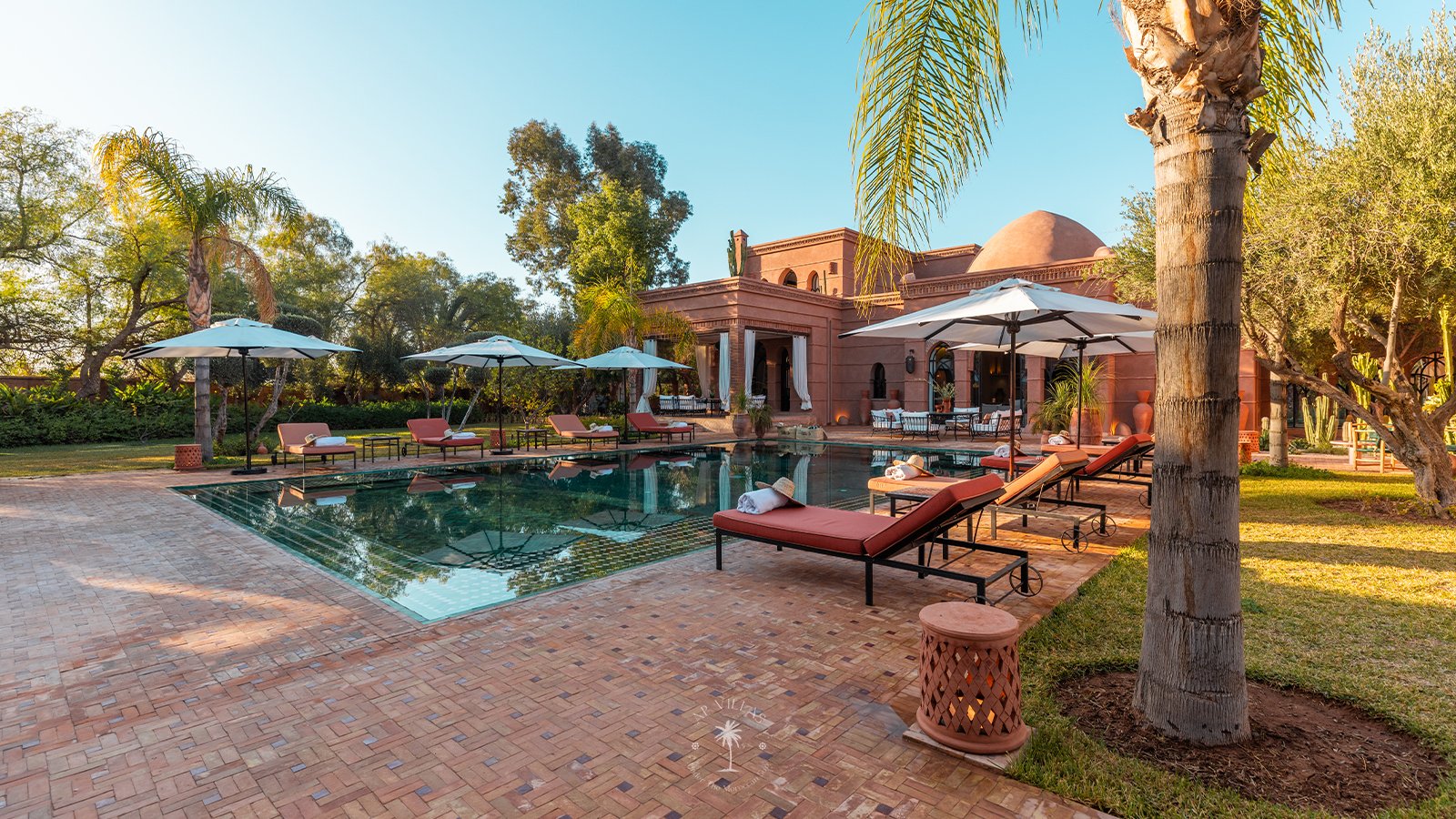A Journey Through Moroccan Cuisine

Morocco, a country where rich history, unique culture and ancient traditions converge in every bite. Exploring Moroccan cuisine is to embark on a journey through age-old culinary practices, vibrant spices and flavors as diverse as the country’s landscapes. The cuisine here is not just about eating to satisfy hunger: it’s a celebration of life, family and community, where every dish has its own story to tell.
Let’s embark on a culinary journey through the rich variety of Moroccan cuisine, from savory tajines to sweet delights that will keep you coming back for more.
Moroccan Mezzes
What better way to start than with the flavorful Moroccan mezzes ? These tasty little dishes often served as appetizers or side dishes and are perfect for sharing, with every bite offering a taste of Morocco’s diverse flavours. A few must-try mezzes include :
- Zaalouk : A dip of smoked eggplant and tomatoes, seasoned with garlic, olive oil and spices.
- Briouats : Crisp pastries filled with spicy meat, cheese, vegetables or sweet almonds.
- Taktouka : A tasty salad with roasted peppers, tomatoes and spices.
Some of these delights are served with “Khobz”, the traditional Moroccan bread that lets you savor every last bite.
Tagine
One of the hallmarks of Moroccan cuisine is the emblematic tagine, a slow-cooked stew made and served in an earthenware pot bearing the same name. More than just a meal, this dish is a symbol of Moroccan hospitality. Recipes for tagine vary from region to region, but they are generally a harmonious blend of tender meats, vegetables, dried fruit and spices such as cumin, cinnamon and saffron.
The most popular versions are Chicken with preserved lemon and olives, lamb with prunes, almonds and apricots, and vegetable tagine.
Tajine is traditionally eaten with bread, which doubles as a utensil and a means of soaking up every last morsel of the savory sauce.
Couscous
Couscous, another popular Moroccan dish that has become an international favorite. Often served on Fridays, the holy day in Islam, couscous symbolizes conviviality and celebration. This dish is made from steamed semolina grains topped with a substantial mix of vegetables, meat ( mostly lamb or chicken) and a delicate blend of spices.
In Morocco, couscous is often served in a large communal dish, encouraging friends and family to get together and share the meal. A particular variant is “Couscous with Tfaya”, prepared with caramelized onions, raisins and a hint of cinnamon for a sweet-and-salty harmony.
Harira
If you are looking for Moroccan comfort food, Harira is at the top of the list. This rich and filling soup, made with tomatoes, chickpeas, lentils fresh herbs and tender pieces of meat, is often eaten during Ramadan – the holy month – to break the fast. Infused with spices like ginger, cumin, turmeric and a hint of cinnamon, Harira is the perfect introduction to Morocco’s love of complex flavors.
This soul-warming soup is usually accompanied by “Chebakia”, a sweet sesame-coated pastry that adds a note of sweetness to the meal.
Moroccan Sweets
A meal in Morocco is not complete without a selection of sweet treats. Traditional Moroccan pastries are rich, delicate and infused with aromatic ingredients such as almonds, honey and orange blossom water. Some of the most popular are :
- Gazelle Horns : Crescent-shaped cookies made with almond paste and enveloped with a thin pastry shell.
- M’hencha : A spiral-shaped pastry filled with marzipan and aromatized with orange blossom.
- Sellou : Nutrient-rich dessert made with roasted flour, almonds, sesame seeds, honey and spices, often served at festive occasions.
Accompany these desserts with a fresh cup of Moroccan mint tea, a sweet and fragrant delight that is an essential part of Moroccan hospitality. Everything about this tea is an art form ; from the preparation to the pouring technique, which makes it a must-try to anyone visiting Morocco.
Spices of Life
No discussion about Moroccan cuisine would be complete without a mention of the country’s famous spices. Take a stroll through any Moroccan souk and you’ll be greeted by the enchanting aroma of spices such as Ras El Hanout (a blend of more than a dozen spices), cumin, cinnamon and saffron. These spices form the backbone of Moroccan cuisine, adding a unique flavor to each dish.
A tour through the spice markets is an unparalleled sensory experience, where vibrant colors and fragrant scents fill the air and heal the soul.
Street Food
For a quick treat, Moroccan street food can be a real adventure in itself. From freshly grilled Kefta (spicy meat brochettes) to Maakouda (potato fritters), the bustling streets of Moroccan cities offer countless opportunities to experience local flavors.
Be sure not to miss the M’semen, a square, flaky Moroccan pancake, typically served with honey or other savory fillings. And if you’re exploring Marrakesh’s famous Jemaa el-Fna square, be sure to try snails in broth, a unique delicacy with a rich, herb-infused taste.
At AP Villas, we believe that the best way to explore Moroccan cuisine is to immerse yourself in the local culture by staying in one of our luxurious properties. Imagine waking up to a hearty Moroccan breakfast, the aroma of freshly baked Khobz and the sound of birds chirping in your private courtyard.
Our properties offer the ideal setting to relax, unwind and savor the flavors of Morocco, with private chefs available to prepare traditional meals tailored to your preferences. All you need to do is book your stay with AP Villas and let us guide you through a culinary adventure like no other.




